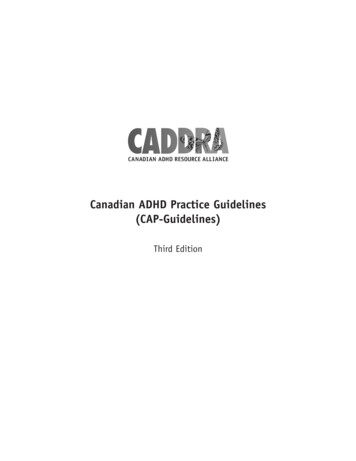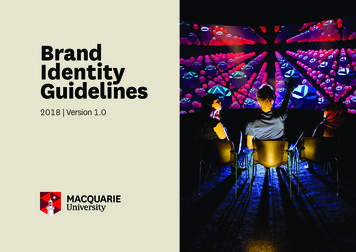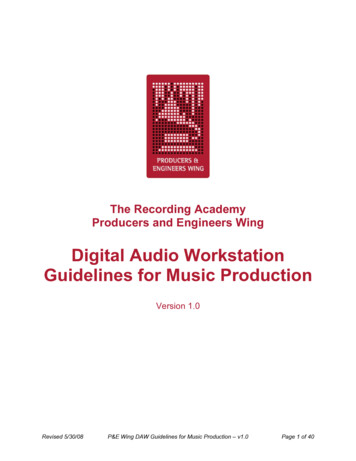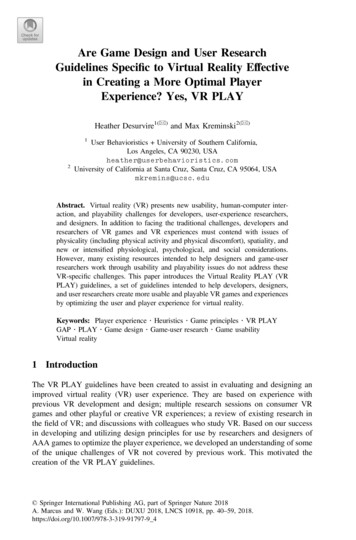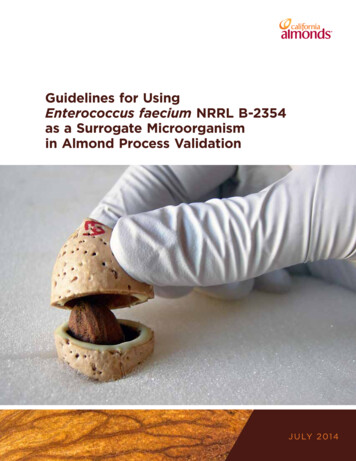
Transcription
Guidelines for UsingEnterococcus faecium NRRL B-2354as a Surrogate Microorganismin Almond Process ValidationJ U LY 2 0 1 4A L M O N D B O A R D O F C A L I F O R N I A G U I D E L I N E 7/ 1 4 1
CONTENTS1SURROGATE CULTURE – BACKGROUND AND BIOSAFETY CONSIDERATIONS2 INOCULUM AND INOCULATED ALMONDS – PREPARATION, HANDLING AND STORAGE2.1 Materials2.2 Preparation timeline2.3 Inoculum preparation2.4 Inoculation procedure and drying2.5 Heat resistance, storage and transport of inoculated almonds3 USE OF SURROGATE IN VALIDATION3.1 Challenge testing with inoculated almonds3.2 Recovery and enumeration of inoculated microorganisms3.3 Dilution and plating schemes3.4 Data reporting3.5 Data calculation examples4 REFERENCESCONTRIBUTORS:Almond Board of California Technical Expert Review Panel (TERP)Ken Stevenson, Ph.D., Chairman ABC TERPKeith Ito, University of California, Davis (Retired) and ConsultantLarry Beuchat, Ph.D., Distinguished Research Professor, Center for Food Safety, University of GeorgiaBradley P. Marks, Ph.D., P.E., Professor, Biosystems Engineering, Michigan State UniversityDave Ashton, Ph.D., Food Safety ConsultantOthersLinda J. Harris, Ph.D., Specialist in Cooperative Extension, University of California, DavisGuangwei Huang, Associate Director, Food Science and Technology, Almond Board of CaliforniaTim Birmingham, Director Quality Assurance and Industry Services, Almond Board of CaliforniaEDITORIAL ASSISTANCESylvia Yada, ConsultantA L M O N D B O A R D O F C A L I F O R N I A G U I D E L I N E 7/ 1 4 2
S E C T I O N1 :SURROGATE CULTURE – BACKGROUND ANDBIOSAFETY CONSIDERATIONSEnterococcus faecium NRRL B-2354 has been identified as a suitable surrogate organism forSalmonella Enteritidis Phage Type 30 and other Salmonellae in validation studies of thermaltreatment processes for almonds. The goal of almond process validation studies is to determineif the treatment technology and equipment can achieve the mandated minimum 4-log reductionof Salmonella in California-grown almonds (Federal Register, 2007; Almonds grown in California,7 CFR part 981).Through studies funded by the Almond Board of California (ABC), the use of E. faecium NRRLB-2354 as a surrogate has been deemed appropriate for use in almond process validationstudies for the following types of processes: Dry-heat processes, such as dry roast, brine and pre-wet dry roast, dry roast flavoring, dryplasticizing, etc. Moist air or steam processes (ambient or vacuum) (Jeong et al., 2011)Enterococcus faecium NRRL B-2354 may also be an appropriate surrogate for alternativeprocesses, such as infrared heating, microwave, radio frequency heating and others. However,before the surrogate is used in validation of other types of processes, studies must be conductedand data gathered to demonstrate appropriate resistance of E. faecium NRRL B-2354 comparedwith Salmonella Enteritidis Phage Type 30 on almonds for the specific process. In addition,studies comparing the resistance of E. faecium NRRL B-2354 and Salmonella Enteritidis PhageType 30 (or other pathogens of concern) should be conducted before using E. faecium NRRLB-2354 as a surrogate for products other than almonds. Furthermore, protocols and guidelinesestablished for use of this surrogate on almonds should not be considered appropriate for otherproducts without additional scientific data to support such application.The strain Enterococcus faecium NRRL B-2354 is available from the culture collection of theUSDA National Center for Agricultural Utilization Research (NCAUR). The ABC Technical ExpertReview Panel (TERP) recommends the use of this strain for almond process validation.NRRL B-2354 cultures can be obtained through NCAUR for no charge via the online orderingsystem for strains in the public access catalog: http://nrrl.ncaur.usda.gov/.A surrogate selected for process validation studies in food processing and pilot plant facilitiesmust be nonpathogenic to humans. E. faecium NRRL B-2354 has been used in the food industryas a nonpathogenic test organism for many decades, also previously under various other namesand strain designations including Micrococcus freudenreichii ATCC 8459, Pediococcus sp.NRRL B-2354 and E. faecium ATCC 8459. A recent review (Kornacki, 2012) indicates theusefulness of E. faecium NRRL B-2354 as a surrogate. Furthermore, a study funded by theAlmond Board of California examining the genomic and functional characteristics of E. faeciumNRRL B-2354 has shown that this strain is a safe surrogate, appropriate for use in processvalidation (Kopit et al., 2014).A L M O N D B O A R D O F C A L I F O R N I A G U I D E L I N E 7/ 1 4 3
S E C T I O N2 :INOCULUM AND INOCULATED ALMONDS –PREPARATION, HANDLING AND STORAGEThe following guidelines describe the materials and step-wise preparation and handlingprocedures for using E. faecium NRRL B-2354 for an almond process validation study, includinginoculum preparation and the storage and transport of inoculated almond samples.2.1 MATERIALSALMOND KERNELS Nonpareil variety, grade U.S. No. 1, size 27/30* (*If this size is not available, contact ABC.)To ensure a low background microbial load on samples, use almonds pasteurized bytreatment with propylene oxide (PPO) and with 300 ppm PPO residueMoisture content of the kernels must be 4.0–5.5% prior to inoculationTemperature of the kernels should be 21–24 C (70–75 F) prior to inoculationCULTURE E. faecium NRRL B-2354EQUIPMENT Plastic petri dishes (standard and 150-mm diameter)PipettesTest tubesGlass spreadersMagnetic stir plate and barsIncubator at 35 C (95 F)Refrigerator at 4 C (40 F)Polyethylene (PE) sample bags, medium size (710 mL/24 oz.)PE sample bags with zipper closure, large size (30 30 cm/16 16 in.)Filter paper sheets (46 57 cm; P8 grade)Metal drying rackPlastic storage bin with lid, sterileMetal mesh trayLaboratory oven, convection/forced airLaboratory paddle blender (e.g., Stomacher lab blender or equivalent)Containers to hold inoculated nuts for treatment (e.g., thermostable bags or baskets)MEDIA Tryptic soy agar (TSA)Tryptic soy broth (TSB)0.1% peptone waterButterfield’s phosphate buffer (BPB)A L M O N D B O A R D O F C A L I F O R N I A G U I D E L I N E 7/ 1 4 4
2.2 PREPARATION TIMELINEDays 1–5:Prepare inoculumDays 5–6: Inoculate almonds, assess initial inoculation levels, and determine heat resistanceDays 7–14: B egin validation trials with inoculated almonds. Note: Use inoculated almonds within14 days after inoculation unless 7.0 log CFU/g is confirmed (see Section 3.2) andadditional heat resistance testing confirms adequate resistance (see Section 2.5)2.3 INOCULUM PREPARATIONThe following procedure will yield a 25-mL suspension of cells, which is a sufficient volume toinoculate one 400-g portion of almonds.The amount of almonds to inoculate is determined by the experimental design: 50 g per sample number of sampling points number of replicates at each sampling point. Typical validation studieswill utilize 2,400 g of inoculated almonds including traveling controls and heat resistance testsamples. The total inoculum volume needed depends on the amount of almonds to be inoculated.Make an appropriate number of 25-mL inoculum preparations and pool as described below.DAY 1Streak culture (active or frozen) onto TSA platesIncubate at 35 C for 24 2 hoursDAY 2Transfer cells from isolated typical colonies into TSB (10 mL)Incubate at 35 C for 24 2 hoursDAY 3Transfer loop of broth culture into TSB (10 mL)Incubate at 35 C overnight (18 2 hours)DAY 4Spread overnight culture (1 mL/plate) over large TSA plates (150 15 mm); prepare 5 platesIncubate at 35 C for 24 2 hoursDAY 5Add 6 mL of 0.1% peptone to each plate, loosen bacterial lawn with a sterile spreader, and usea sterile pipette to collect cells into a sterile container. (Add additional peptone as needed fortotal volume of 25 mL per 5 petri dishes.)Before inoculating almonds, pool all 25-mL inoculum preparations and mix thoroughly for atleast 1 minute using a magnetic stir bar and stir plateHold pooled inoculum on stir plate (for up to 0.5 hour) until all almond samples havebeen inoculatedA L M O N D B O A R D O F C A L I F O R N I A G U I D E L I N E 7/ 1 4 5
2.4 INOCULATION PROCEDURE AND DRYINGThe following inoculation procedure is for one 400-g portion of almond kernels. To prepare moreinoculated almonds, separately inoculate 400-g batches of almonds and pool after drying asdescribed below.DAY 5Weigh Nonpareil almonds (400 1 g) intolarge PE bag (sterile), add 25 mL of pooledinoculum, and seal bagMix contents of sealed bag by inverting thebag repeatedly by hand for 1 minutePour almonds out of bag and spread ontofilter paper (4 layers) placed on a metaldrying rack inside a lidded bin (sterile)Before inoculating: Hand-sort almondsto remove defects including broken andchipped/scratched nutsMake sure that almond moisture contentis 4.0–5.5% and almonds are temperedto room temperature (21–24 C)To make four layers of filter paper, foldtwo large sheets in halfAllow inoculated almonds to dry in bin (withlid ajar) at ambient temperature (24 2 C)for at least 24 hoursDAYS 6–7Pool batches of dried inoculated almondsinto sterile PE storage bag, and mix contentsby shaking bag by hand for 2 minutesAlmonds should be air dried until themoisture content is less than 5.5%. Thismay take up to 72 hours, dependingon the ambient relative humidityDetermine inoculation levelLevel must be 7 log CFU/gDetermine heat resistanceSee Section2.5 for heatresistance testSee Section 3.2for enumerationmethodsA L M O N D B O A R D O F C A L I F O R N I A G U I D E L I N E 7/ 1 4 6
2.5 H EAT RESISTANCE, STORAGE ANDTRANSPORT OF INOCULATED ALMONDSFollow the handling procedures for inoculated almonds (and uninoculated controls) as indicatedbelow before starting challenge testing.Determine heat resistanceHEAT RESISTANCE TESTNote: Test inoculated almonds immediately after dryingand again before validation trials if dried samples arestored for more than 14 daysStep 1: Spread 25 g dried inoculated almonds onmetal mesh tray and space kernelsStep 2: Heat in convection/forced air oven at 280 F(138 C) for 15 minutesHeat resistance is determined bysubtracting the lowest log valueof survivors (heated samples)from highest log values ofnon-heated, inoculated controlsStep 3: Enumerate heated sample and control(unheated inoculated almonds): Section 3.2Acceptable heat resistance 2.5 log reductionSTORAGEStore dried inoculated almonds at 4 C 1 C0–14 days post-inoculation 14 days post inoculationUse almonds in validationtrials if testing confirms 7 log CFU/g and4.0–5.5% moistureINOCULATED SAMPLE PACKSLoosely pack almonds (50-g portions) into meshbags, baskets, or other suitable container that canbe incorporated into processing line Prepare enough sample packs for each validationrun to cover all sampling points on line Also prepare triplicate inoculated sample packs toserve as “traveling” controlsOr prepare sample packs aftertransporting stored almonds toprocessing siteIf 50-g packs are not feasible withprocessing system, contact ABCTRANSPORTTransport and handle dried inoculated samples andinoculated traveling controls in identical manner onday(s) of validation trialA L M O N D B O A R D O F C A L I F O R N I A G U I D E L I N E 7/ 1 4 7
S E C T I O N3 :USE OF SURROGATE IN VALIDATIONThe following guidelines describe steps in challenge testing with surrogate organismEnterococcus faecium NRRL B-2354 in an almond process validation study as well asthe procedures for recovery and enumeration.3.1 C HALLENGE TESTING WITHINOCULATED ALMONDSTo run meaningful process validation trials, it is important to map the temperature of the processingline or product containers to identify potential cold spots before running validation trials. Conductmicrobial challenge testing at identified cold spots and under conditions that will always beexceeded during normal operation. For example: For dry-roaster validation, conduct testing withtemperature set points lowered. For normal production, increase set points and establishtemperature critical factors that exceed the maximum values reached during validation testing.CONDITIONINGCondition inoculated almonds to teperatureof carrier product in processling line.INOCULATED SAMPLE PACK POSITIONINGFor conveyor lines—embed sample packsamong product on bedFor non-conveyor lines—add sample packsto mix with product flowTHERMAL TREATMENTConduct thermal treatment trial withinoculated sample packs in processing lineInoculated sample packs should beplaced uniformly in the process and inall identified coldspots/zonesPerform a minimum the three validationruns to address each process variationResults may dictate need for additionaltestingSAMPLE RETRIEVALRetrieve treated inoculated sample packsfrom line—chill hot sample packs immediatelyin an ice bath or chilled waterTo chill, double bag sample pack insterile sample bags. Seal and place inice bath or chilled waterHold treated samples at 0–4 C.Enumerate E. faecium in samples within24 hours of treatmentSee Section 3.2 for enumeration methodsA L M O N D B O A R D O F C A L I F O R N I A G U I D E L I N E 7/ 1 4 8
3.2 R ECOVERY AND ENUMERATION OFINOCULATED MICROORGANISMSRecover and enumerate inoculated E. faecium on all samples (inoculated and uninoculated[control] almonds) by following the ABC protocol or the procedure described in the FDABacteriological Analytical Manual (BAM) (Andrews and Hammack, 2003).ALMOND SAMPLES Controls (uninoculated) Inoculated Traveling Controls (untreated) Inoculated Samples (treated)ABC PROTOCOLFDA BAM PROCEDUREAdd almonds to TSB (at ambient temperature)in a 1:2 w/v ratio in a sterile medium-sizebag—i.e., 25 g of almonds to 50 mL TSB forheat test samples, and 50 g almonds to100 mL TSB for validation studyAdd almonds to BPB (at ambient temperature)in a 1:1 w/v ratio in a sterile medium-size bag— i.e., 25 g of almonds to 25 mL BPB for heatt
ALMOND BOARD OF CALIFORNIA GUIDELINE 7/14 1 Guidelines for Using Enterococcus faecium NRRL B-2354 as a Surrogate Microorganism in Almond Process Validation JULY 2014. ALMOND BOARD OF CALIFORNIA GUIDELINE 7/14 2 CONTENTS 1 SURROGATE CULTURE – BACKGROUND AND BIOSAFETY CONSIDERATIONS 2 INOCULUM AND INOCULATED




